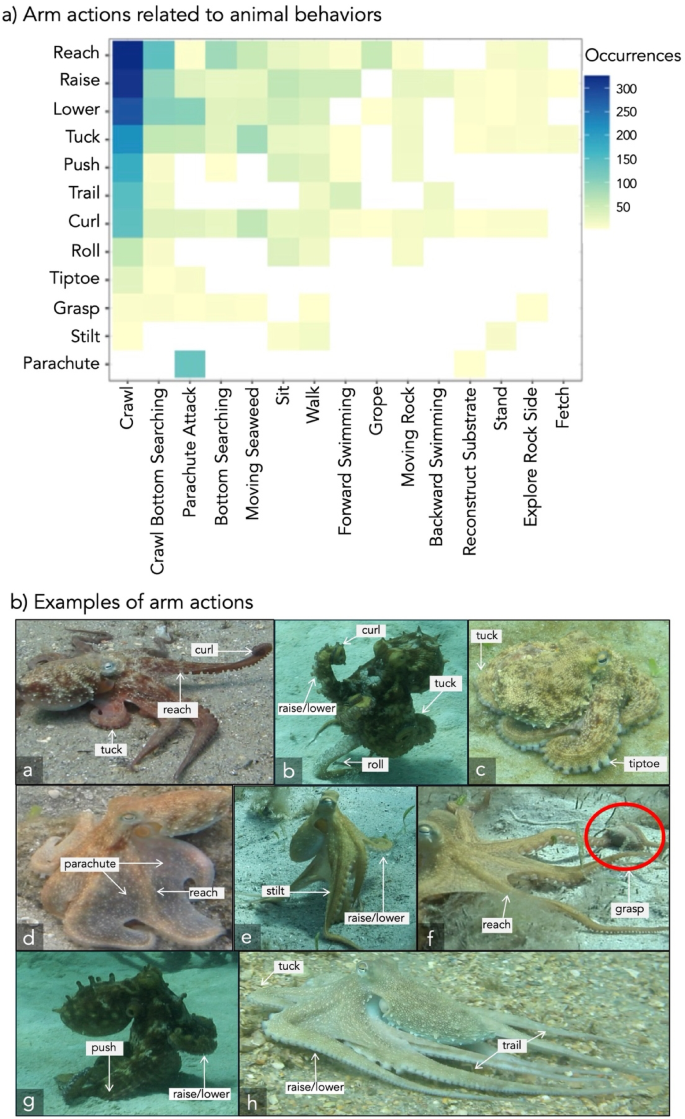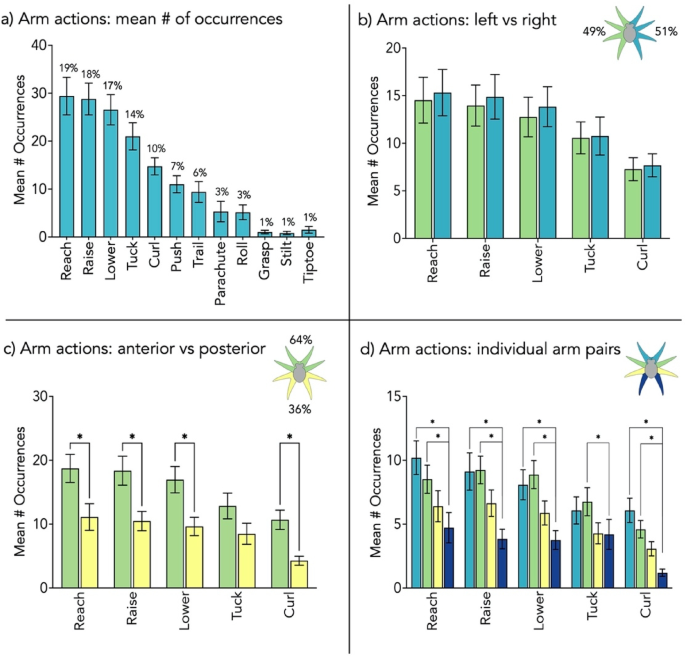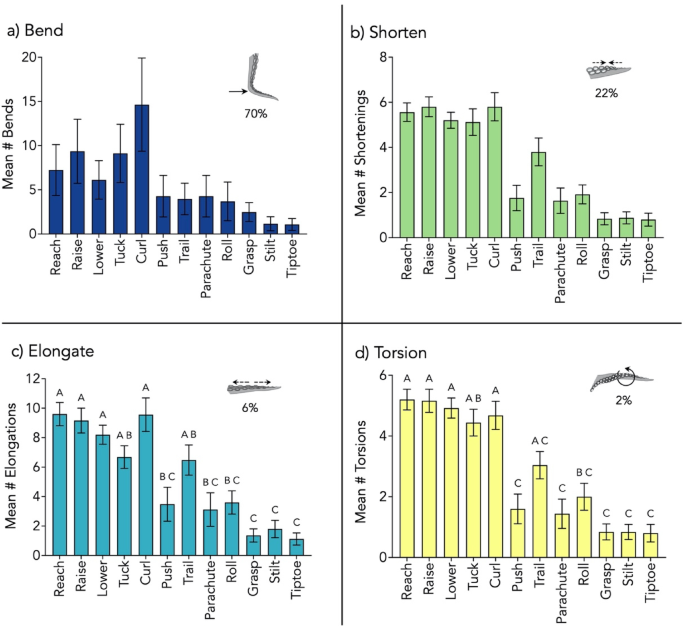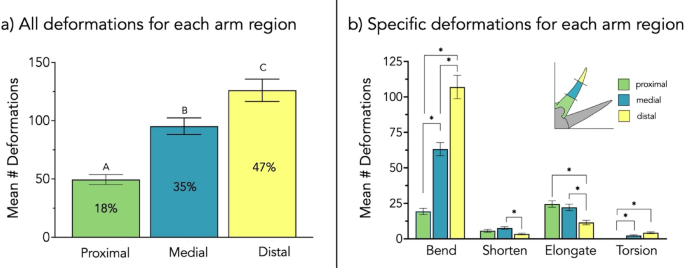Arm actions
Twelve arm actions were identified from 15 behaviors with a total of 3,907 actions recorded from 25 wild octopuses (total 25 min, 1-min per octopus) across 6 field sites with varying ecohabitats. The majority of these actions were observed across multiple behaviors. Many actions were observed during the behaviors of crawl (11/12 actions), crawl speculative bottom searching (10/12 actions), moving seaweed (8/12 actions), and parachute attack (8/12), while few actions were observed for backward swimming (3/12 actions), grope (3/12 actions), and fetch (2/12 actions) (Fig. 3a). While recording actions for each arm, it was noted that for a single behavior, multiple arm actions could occur simultaneously on the same arm and/or on adjacent arms (Fig. 3b).Five of these arm actions accounted for 78% of the total arm actions recorded: reach 19%, raise 18%, lower 17%, tuck 14%, and curl 10% (Fig. 4a). These 5 actions were also used across the majority of behaviors (Fig. 3a). Actions observed less frequently included parachute, roll, grasp, stilt, and tiptoe (Fig. 4a).
Arm actions and their relationship to animal behaviors. (a) A heat map depicting the number of arm action occurrences for specific behaviors (n = 25 octopuses). (b) Examples of all 12 arm actions from wild octopuses; octopuses often used multiple arm actions on a single arm or multiple arms simultaneously.
Frequency and distribution of arm actions in naturally behaving octopuses. (a) Mean number of occurrences of all arm actions. Percentages above each bar indicate the overall percent occurrence of each action (rounded to the nearest %). Reach, raise, lower, and curl together accounted for 78% of all actions. (b) Mean number of occurrences of arm actions performed by the left versus right arms; arm actions were used with equal frequency on the left (49%) and right (51%) sides of the body (reach: U4 = 302.0, P = 0.844; raise: U4 = 306.5, P = 0.912; lower: U4 = 297.0, P = 0.769; tuck: U4 = 305.0, P = 0.889; curl: U4 = 292.5, P = 0.703). (c) Anterior arms (64%) were used more frequently than posterior arms (36%) for reach (U4 = 172.0, P = 0.006), raise (U4 = 182.5, P = 0.010), lower (U4 = 175.0, P = 0.007), and curl (U4 = 140.5, P < 0.001). (d) Arm pairs 1 and 2 were used more frequently than arm pair 4 for reach (1 vs 4: U4 = 144.0, P < 0.001; 2 vs 4: U4 = 166.5, P = 0.004), raise (1 vs 4: U4 = 171.5, P = 0.005; 2 vs 4: U4 = 130.0, P < 0.001), lower (1 vs 4: U4 = 174.0, P = 0.006; 2 vs 4: U4 = 133.5, P < 0.001), and curl (1 vs 4: U4 = 98.5, P < 0.001; 2 vs 4: U4 = 114.5, P < 0.001), and arm pair 2 was also used more frequently than arm pair 4 for tuck (U4 = 210.0, P = 0.044). Mann-Whitney U tests were used for all comparisons of the occurrences of the top 5 arm actions between: left versus right arms, anterior versus posterior arms, and individual arm pairs (n = 25 octopuses). Error bars indicate standard error of the mean. Asterisks depict statistically significant differences in frequency of actions.
Overall, the right and left arms performed relatively the same number of actions (49%, 51%, respectively). When observing individual arm action occurrences for the five most frequently occurring actions, Mann-Whitney U tests with FDR correction indicated no significant difference between left and right arms (Fig. 4b, reach: U4 = 302.0, P = 0.844; raise: U4 = 306.5, P = 0.912; lower: U4 = 297.0, P = 0.769; tuck: U4 = 305.0, P = 0.889; curl: U4 = 292.5, P = 0.703). Comparisons for left vs right arms for all 12 arm actions can be viewed in Supplementary Information (Figure S1a).
Arm actions differed when comparing the 5 most frequently occurring actions between anterior arm pairs (1 and 2) and posterior arm pairs (3 and 4) (Fig. 4c). Anterior arms were used an average of 64% and posterior arms were used an average of 36% of the time. Anterior arms were used more frequently than posterior arms for reach (U4 = 172.0, P = 0.006), raise (U4 = 182.5, P = 0.010), lower (U4 = 175.0, P = 0.007), and curl (U4 = 140.5, P < 0.001). For a breakdown of each arm action: reach occurred 63% in anterior arms and 37% in posterior arms, raise occurred 64% in anterior arms and 36% in posterior arms, lower occurred 64% in anterior arms and 36% in posterior arms, tuck occurred 60% in anterior arms and 40% in posterior arms, and curl occurred 71% in anterior arms and 29% in posterior arms. Two actions were used more frequently by posterior arms than anterior arms—stilt (posterior: 63%, anterior: 37%) and roll (posterior: 71%, anterior: 29%). These additional comparisons for anterior vs posterior arms can be viewed in Supplementary Information (Figure S1b).
There were differences in arm action occurrences between individual arm pairs (1–4) for the most commonly occurring 5 actions (Fig. 4d). Arm pairs 1 and 2 were used more frequently than arm pair 4 for reach (1 vs 4: U4 = 144.0, P < 0.001; 2 vs 4: U4 = 166.5, P = 0.004), raise (1 vs 4: U4 = 171.5, P = 0.005; 2 vs 4: U4 = 130.0, P = < 0.001), lower (1 vs 4: U4 = 174.0, P = 0.006; 2 vs 4: U4 = 133.5, P < 0.001), and curl (1 vs 4: U4 = 98.5, P < 0.001; 2 vs 4: U4 = 114.5, P < 0.001), and arm pair 2 was also used more frequently than arm pair 4 for tuck (U4 = 210.0, P = 0.044). Comparisons for individual arm pairs (1- 4) for all 12 arm actions can be viewed in Supplementary Information (Figure S1c).
Arm deformations
A total of 6,781 arm deformations were recorded from the 25 individual octopuses. All 4 deformations (bend, shorten, elongate, and torsion) were observed in all 8 arms of the octopuses. Bend was the most frequently used (70%; 4,750 occurrences) followed by elongate (22%; 1,458 occurrences), shorten (6%; 410 occurrences) and torsion (2%; 63 occurrences). Bending was used with similar frequency across all arm actions (Kruskal-Wallis one-way ANOVA, H11 = 9.90, P = 0.540; Fig. 5a). Shorten was used more frequently for reach, raise, lower, tuck, and curl than for push, parachute, roll, grasp, stilt, and tiptoe (Kruskal-Wallis one-way ANOVA, H11 = 147.1, P < 0.001; Fig. 5b; Dunn’s multiple comparison tests, P < 0.05, see Table S1 for specific Z-scores and adjusted P-values). Elongate was used more frequently for reach, raise, lower, and curl than for push, parachute, roll, grasp, stilt, and tiptoe (Kruskal-Wallis one-way ANOVA, H11 = 129.7, P < 0.001; Fig. 5c; Dunn’s multiple comparison tests, P < 0.05, see Table S2 for specific Z-scores and adjusted P-values). Although torsion was used least often, the arm actions reach, raise, lower, and curl were used more often than push, parachute, roll, grasp, stilt, and tiptoe (Kruskal-Wallis one-way ANOVA, H11 = 142.0, P < 0.001; Fig. 5d; Dunn’s multiple comparison tests, P < 0.05, see Table S3 for specific Z-scores and adjusted P-values).
Frequency of arm deformations used for each arm action in naturally behaving octopuses. Overall, bend was the most frequently used (70%) followed by elongate (22%), shorten (6%) and torsion (2%). (a) Mean number of bends used for each action; bends were used with equal frequency for all arm actions (Kruskal-Wallis one-way ANOVA, H11 = 9.895, P = 0.540). (b) Mean number of shortenings for each arm action; the shorten deformation was used more frequently for some arm actions than others (Kruskal-Wallis one-way ANOVA, H11 = 147.1, P < 0.001). Dunn’s multiple comparison tests (two-sided) indicated that reach, raise, lower, tuck, and curl used shorten more often than push, parachute, roll, grasp, stilt, and tiptoe (P < 0.05, see Table S1 for specific Z-scores and P-values). (c) Mean number of elongations for each arm action; the elongate deformation was used more frequently for some arm actions than others (Kruskal-Wallis one-way ANOVA, H11 = 129.7, P < 0.001). Dunn’s multiple comparison tests (two-sided) indicated that reach, raise, lower, and curl used elongate more often than push, parachute, roll, grasp, stilt, and tiptoe (P < 0.05, see Table S2 for specific Z scores and P values). (d) Mean number of torsions for each arm action; some actions used torsion more often than others (Kruskal-Wallis one-way ANOVA, H11 = 142.0, P < 0.001). Dunn’s multiple comparison tests (two-sided) indicated that the arm actions reach, raise, lower, and curl used torsion more often than push, parachute, roll, grasp, stilt, and tiptoe (P < 0.05, see Table S3 for specific Z-scores and P-values). Error bars indicate standard error of the mean. Different letters indicate statistically significant differences between arm actions (n = 25 octopuses).
There were significant differences in the number of deformations used in distal (47%), medial (35%) and proximal (18%) arm regions (Fig. 6a; one-way ANOVA, F2 = 27.79, P < 0.001; Tukey’s post hoc tests adjusted P < 0.001). There were also significantly different numbers of occurrences for each type of deformation (Fig. 6b). Bend occurred most frequently in the distal arm region, followed by the medial, then proximal arm regions (Kruskal-Wallis one-way ANOVA, H2 = 50.88, P < 0.001; Dunn’s multiple comparison tests: distal vs medial adjusted P = 0.027, distal vs proximal adjusted P < 0.001; medial vs proximal adjusted P < 0.001). Shorten occurred more often in the medial arm region than in the distal arm region (Kruskal-Wallis one-way ANOVA; Dunn’s multiple comparison tests: adjusted P = 0.025). Elongate occurred more frequently in the proximal and medial arm regions compared to the distal arm region (Kruskal-Wallis one-way ANOVA; Dunn’s multiple comparison tests: proximal vs distal adjusted P < 0.001; medial vs distal adjusted P = 0.003). Torsion was not observed in the proximal arm region and occurred significantly more often in the medial and distal arm regions (Kruskal-Wallis one-way ANOVA; Dunn’s multiple comparison tests: proximal vs medial adjusted P < 0.001; proximal vs distal adjusted P < 0.001).
Frequency of arm deformations for each arm region (proximal, medial, distal). (a) The mean number of deformations were unequally distributed within each part of the arm: distal (47%), medial (35%), and proximal (18%) (One-way ANOVA, F2 = 27.79, P < 0.001). Tukey’s post hoc tests showed that the distal part of the arms performed a greater number of arm actions (M = 126.1) than the proximal (M = 49.48, adjusted P < 0.001) and medial parts of the arms (M = 95.28, adjusted P = 0.011) and the medial part of the arms performed a greater number of arm actions than the proximal part of the arm (adjusted P < 0.001). (b) Bending was unequally distributed within each part of the arm (Kruskal-Wallis one-way ANOVA, H2 = 50.88, P < 0.001). Dunn’s multiple comparison tests (two-sided) indicated that bends occurred most frequently in the distal part of the arm (M = 107.0), followed by the medial (M = 63.20, distal vs medial adjusted P = 0.027) and then the proximal (M = 19.28, distal vs proximal adjusted P < 0.001; medial vs proximal adjusted P < 0.001) parts of the arm. Shortening occurred more often in the medial part of the arm (M = 7.60) than in the distal part of the arm (M = 3.4, adjusted P = 0.025); elongate occurred more frequently in the proximal (M = 24.52) and medial (M = 22.16) parts of the arm as compared to the distal (M = 11.48) part of the arm (proximal vs distal adjusted P < 0.001; medial vs distal adjusted P = 0.003); torsion was not observed in the proximal part of the arm and occurred significantly more often in the distal (M = 4.28, adjusted P < 0.001) and medial parts of the arm (M = 2.32, adjusted P < 0.001). Different letters indicate statistically significant differences between arm regions (n = 25 octopuses). Asterisks depict statistically significant differences.
Laboratory versus field comparison
These field results can be compared with those of our previous laboratory study of O. bimaculoides17. That study did not create a specific behavioral ethogram; however, aquarium environments were created to elicit a reasonable diversity of behavioral responses to record a range of deformations for each arm and arm region. More deformations were scored in the laboratory setting, yet the results of both laboratory and field studies showed similar trends for the majority of arm deformation comparisons. Each study exhibited all 4 deformations used in all 8 arms and in all 3 arm regions with the single exception of torsion in this field study. Both studies reported bend being the most frequently used deformation followed by elongate, shorten, and torsion (respectively) and deformations occurring more frequently in anterior arms versus posterior arms. The most visible differences were for bend and elongate (Supplementary Information Fig. 2a,b).
For left versus right arms, the laboratory study indicated that all deformations occurred more frequently for the right arms with the exception of right arm 3 (R3). Although our field results showed deformations occurring slightly more often for right arms than left arms (including R3), we found no significant differences for left versus right arms when arm actions were compared. For anterior vs posterior arms, the laboratory study found that arm pair 1 had a larger number of deformation occurrences than the other 3 arm pairs, whereas this field study (for arm actions) illustrated differences for both anterior arm pairs 1 and 2 as compared to arm pair 4. Similar trends were observed for our deformations for arm pairs (1–4) (Supplementary Information Fig. 2c,d).
For specific arm regions, both studies reported similar results with bends occurring most frequently in the distal and medial arm regions. Elongate and shorten shared the same trends with both occurring most often in proximal region and least often in the distal arm region. For the laboratory study, torsion occurred across all 3 regions with no significant difference whereas in the field, torsion occurred significantly more often in both the distal and medial arm regions than the proximal arm region where it was not reported (Supplementary Information Fig. 2e,f).





